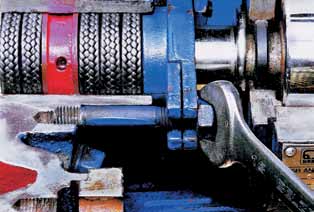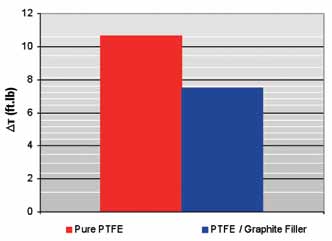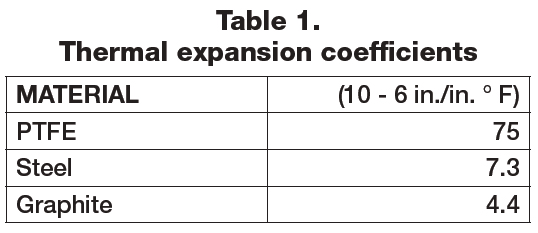For many years, industry has recognized the inherent benefits of braided packings produced from PTFE fiber. Low coefficient of friction and outstanding chemical stability make it well-suited for sealing aggressive fluids in rotating equipment—such as agitators, mixers and pumps.
However, PTFE exhibits some undesirable mechanical properties—such as stress relaxation and temperature dependence. These properties may cause problems in certain applications unless measures are taken to alleviate their influence.
Laboratory tests performed with different pumps and media and subsequent field observations show that these temperature-driven property changes have a major influence on PTFE packing behavior and can be controlled.

Thermal Expansion Coefficient
The thermal expansion coefficient is a material property that is indicative of the extent to which a material expands upon heating. Metals and non-metals expand by different amounts because of the difference in this coefficient.
The thermal expansion of most materials is linear over small temperature ranges and proportional to temperature changes. Most solid materials expand upon heating and contract when cooled.
In a sealing system, the thermal expansion coefficient will determine how much the packing will grow relative to its metal components when heated. Since PTFE has a high thermal expansion coefficient and a low thermal conductivity, it can exhibit relatively high thermal expansion.
PTFE packing has a tendency to absorb the frictional heat generated by the contact of the packing with the rotary shaft, not allowing it to dissipate, raising temperature and causing expansion. Observations have been made that some PTFE packing would perform well during plant start-up, but as the temperature increased to operating conditions, the packing would overheat and extrude, making leakage control nearly impossible.
PTFE Thermal Expansion Offset

Approaches to offset the thermal expansion characteristics can be applied. These include methods to increase PTFE thermal stability or keep the sealing system temperature stable.
Lubricants
Lubricants added during the packing manufacturing process help minimize friction during start-up and break-in, and they keep the sealing system temperature stable. These lubricants are available in many types and forms (greases, emulsions and dispersions, for example) and should always be compatible with the packing application.
Flush Systems
Flush water can be used in a pump packing installation—using lantern rings—to allow lubrication and cooling between the PTFE packing and the shaft when lubricants cannot provide sufficient cooling or are not allowed. Excessive flush pressure can provide unwanted packing compression, and this can cause greater frictional heat and consequently thermal expansion. To avoid this problem, follow the installation procedures from the packing manufacturer.
Fillers
PTFE mechanical properties can be enhanced by adding fillers. Characteristics—such as type, particle shape and size and the chemical composition of the filler—greatly affect the properties of the compound.
The thermal expansion coefficient of a large number of PTFE fillers is significantly smaller than that of the PTFE. When added to PTFE these filled PTFE packings expand less than unfilled PTFE.
Table 1 shows that the thermal expansion of PTFE is about seventeen times greater than graphite. For this reason, graphite is the most commonly used filler material in PTFE packings.

Test Results
Laboratory tests comparing PTFE packing behavior when subjected to temperature cycles show a direct correlation between the amount of filler and the torque needed to turn the shaft. The higher the filler content the lower the increase in shaft torque, with cycling from room temperature to 212 degrees F (100 degrees C).
Even under laboratory conditions, controlling the leak rate for an unfilled PTFE packing is difficult. The packing shows very high leakage as every gland adjustment led to temperature increases and consequent scorching of the packing and leak rate increases. Filled PTFE packings provide good performance, reacting well to gland adjustments and keeping a stable leak rate.
Conclusions
Thermal expansion plays a major role in PTFE pump packing performance. Packing expansion from temperature increases can greatly increase stuffing box internal stresses leading to high shaft torque and, eventually, scorching the packing. The opposite can also happen when systems cool down. The reduction of gland stress associated with high thermal contraction can produce high leak rates.
Some remedies—such as lubricants and flush system installation—can be applied to keep the sealing system temperature stable and avoid packing thermal expansion. The addition of fillers can also be a solution, increasing PTFE thermal stability.
Unfilled PTFE packings should be monitored to control leakage. Higher quality PTFE packings that incorporate fillers and lubricants along with flushing systems are capable of meeting a wide range of pump applications.
Next Month: What are the challenges with sealing water applications?
Pumps & Systems, September 2011
“Sealing Sense” is produced by the Fluid Sealing Association (FSA) as part of our commitment to industry consensus technical education for pump users, contractors, distributors, OEMs and reps. As a source of technical information on sealing systems and devices, and in cooperation with the European Sealing Association (ESA), FSA also supports the development of harmonized standards in all areas of fluid sealing technology. The education is provided in the public interest to enable a balanced assessment of the most effective solutions to pump systems technology issues on rational total life cycle cost principles.
The Compression Packing division of the FSA is one of six with a specific product technology focus. As part of its mission, it develops publications such as the recently published joint FSA/ESA Compression Packing Technical Manual and the Pump &Valve Packing Installation Procedures pamphlets. These are primers intended to complement the more detailed manufacturer's documents produced by the member companies. In addition to English, some are available in a number of other languages, including Spanish and German.
The following members of the Compression Packing division sponsor this “Sealing Sense”:
- American Braiding & Mfg.
- ChemStar Mechanical Packing, Inc.
- A. W. Chesterton Co.
- Daikin America, Inc.
- EGC Enterprises, Inc.
- Empak Spirotallic Mexicana SA de CV
- Garlock Sealing Technologies
- W.L. Gore & Associates, Inc.
- GrafTech International Holdings, Inc.
- John Crane
- Latty International S.A.
- Lenzing Plastics GmbH
- Nippon Pillar Corporation of America
- Palmetto, Inc.
- SEPCO - Sealing Equipment Products Co.
- SGL Technic Polycarbon Division
- Slade, Inc.
- Teadit International
- YMT/Inertech, Inc.
